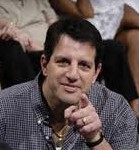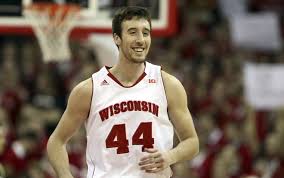 Like most fans, I found this season’s Final Four to be really good. I guess college basketball isn’t being ruined by “one-and-done” after all. While we saw a one-and-done factory (Duke) win it all, we also had a sighting of a dodo bird. That creature thought to be extinct, known as a senior star.
Like most fans, I found this season’s Final Four to be really good. I guess college basketball isn’t being ruined by “one-and-done” after all. While we saw a one-and-done factory (Duke) win it all, we also had a sighting of a dodo bird. That creature thought to be extinct, known as a senior star.
Wisconsin coach Bo Ryan prides himself on building from within and having well-coached teams. He develops players and teams over time by having rosters dominated by kids from small Wisconsin and Illinois towns that end up having long college careers. He succeeded admirably and was a few buckets away from having a dynasty in Madison.
Badgers center Frank Kaminsky had a fantastic season, winning most of the college Player of the Year awards, but he is still expected to be drafted after fellow big men Jahlil Okafor of Duke and Karl-Anthony Towns from Kentucky.
The more I watched Kaminsky play, the more I understood why the media finds him difficult to define. I dealt with the same issues in my career as a square peg. During my career, the center position was defined by great low post play. There were 10 20,000-point scorers active during my career, including Kareem Abdul-Jabbar, Hakeem Olajuwon, Moses Malone, Robert Parish and Patrick Ewing. There were only a couple of oddities like Dan Issel who faced up and scored from outside.
Today’s game has centers that are rim protectors. They are predominantly shot-blockers whose offensive contributions are a bonus. The position has changed so much that it isn’t even listed on the All-Star ballot anymore.
As the development cycles of players get shorter, the position most affected is the one that takes the longest to learn, the center spot. Most centers aren’t 7-footers until they are 17 or 18, and by then many are pro-ready. They became Kevin Durant or Chris Bosh. They face up and shoot threes. They don’t slug it out in the post with bulk and footwork.
 Kaminsky is an oddity. He played four years in college. He has a complete game. When I watch him, I see a player very much like myself. Stating the obvious, we are both tall white guys who wore number 44 in college. In addition, we both were late bloomers. Kaminsky didn’t become a starter until his junior year; I started only as a senior. We both grew up with strong basketball influences at home. His father played college ball, mine played in the NBA. We both hung around pro teams as kids, getting the spirit of the pro game. He hung around the Michael Jordan Bulls, while I was a ball boy for the Buffalo Braves.
Kaminsky is an oddity. He played four years in college. He has a complete game. When I watch him, I see a player very much like myself. Stating the obvious, we are both tall white guys who wore number 44 in college. In addition, we both were late bloomers. Kaminsky didn’t become a starter until his junior year; I started only as a senior. We both grew up with strong basketball influences at home. His father played college ball, mine played in the NBA. We both hung around pro teams as kids, getting the spirit of the pro game. He hung around the Michael Jordan Bulls, while I was a ball boy for the Buffalo Braves.
We both get the same comments about our perceived lack of athleticism since we don’t use the dunk as our primary offensive weapon. Yet I see him going around “quicker” guys, and I played the bulk of my career on the fastest-running, highest-scoring team in NBA history and always got in on the action.
I was once asked in an interview to describe my game in one word. My answer was simple: effective.
Like Kaminsky, my game wasn’t easy to categorize. I was a strong low-post scorer who could shoot out to 20 feet, an adept passer and a position defender with an exceptional fundamental knowledge of the game. But I wasn’t flashy. I wasn’t the SportsCenter highlight guy. Kaminsky’s game is very similar. It was deja vu seeing a center actually box out when getting a rebound.
So what is Kaminsky? Is he the poster boy for why kids should stay in college longer?
Is he the prototype of the next generation center? Or is he proof that the center position is dead? After all, the Wisconsin roster lists him as a forward. Maybe he is the next Danny Manning, a player who didn’t fit any position’s description.
At the end of the day, I was the second center selected in a draft class dominated by underclassmen. It sounds like a similar fate awaits Kaminsky. I hope the team that picks him has the vision to see beyond the obvious. I think he may pioneer a new position.
Ballplayer.
Danny Schayes is a Director of Business Optimization at Intensity and a leader in the business of professional sports. Schayes frequently advises sports organizations in complex business matters that include contract negotiations, pricing strategy, marketing optimization, and executive leadership. Follow him on Twitter.
MORE COLUMNS FROM DANNY SCHAYES
Then allow me to define him: A future white American NBA scrub. You were a role player. The reason you lasted so long is because besides height, you had more smarts than other role players, even though you weren’t all that skilled, per se. Year after year, you figuratively cheated the system with smarts, and by the fact the NBA was a much slower game. (As opposed to your old college coach, who year after year, literally cheated the system.)
Kaminsky is going to last as long in the NBA as Tyler Zeller, or less. Kaminsky’s stone feet in today’s NBA will make him the 21st century version of Hank Finkel. Some really tall white American dude that has no business being on an NBA court, but there’s always going to be some dumbbell GM that will put him on a 15-man roster strictly because of his height, and because he has a brain that allows him to count to 20 using his fingers and his toes. At least half of today’s NBA can’t even do that.
You couldn’t be a tad more racist could you?